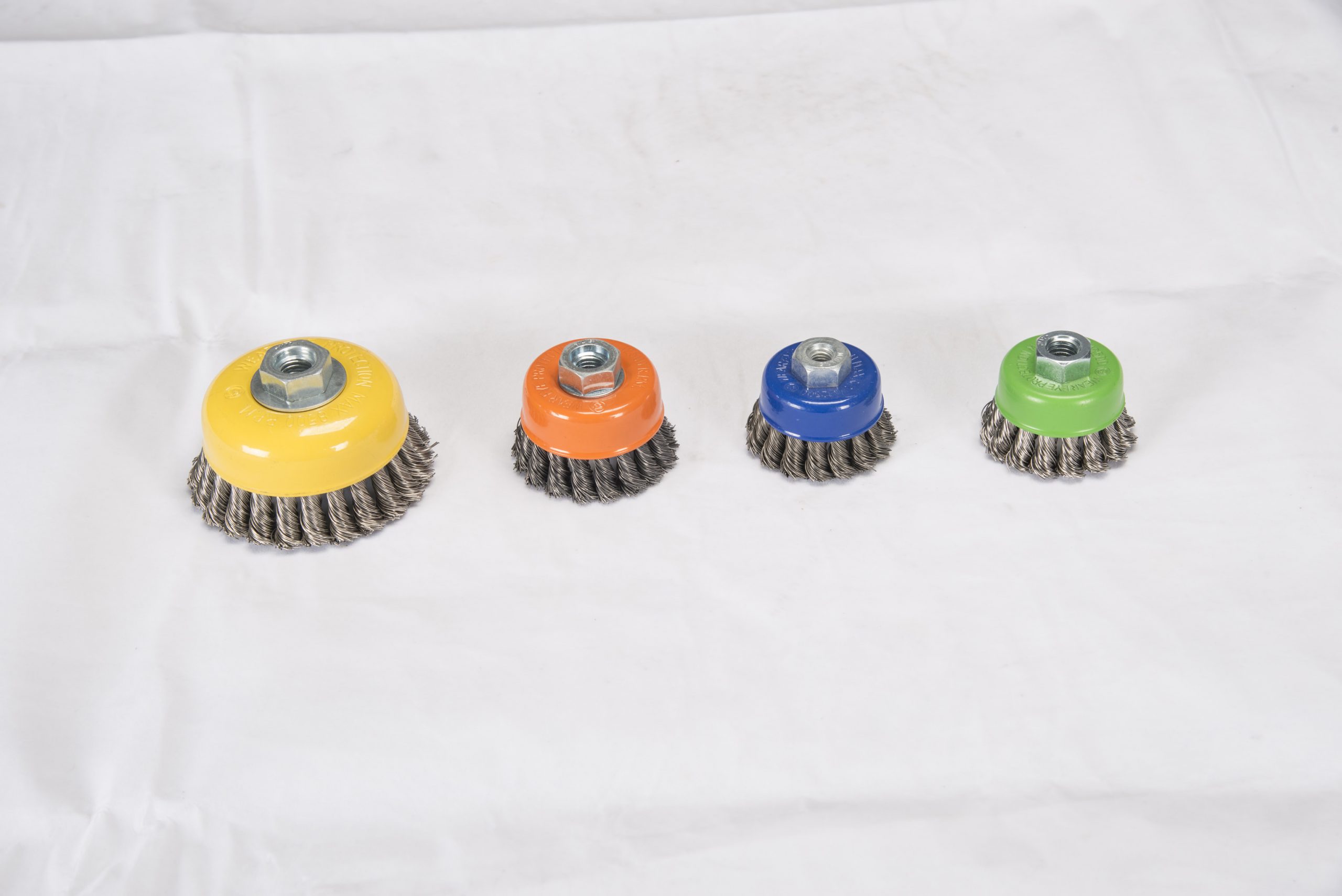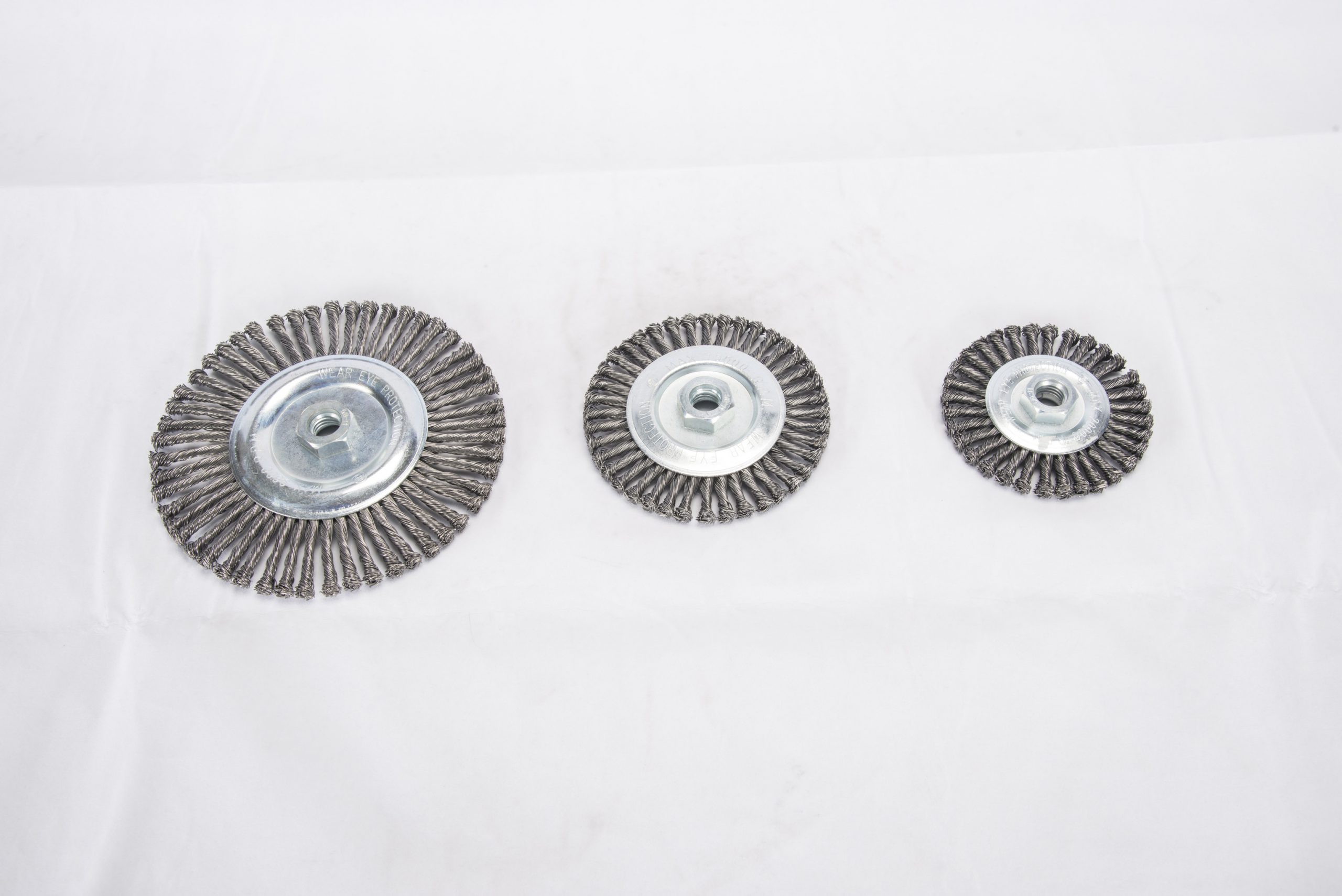When it comes to surface preparation, cleaning, and material removal in metalworking, two popular tools often come to mind: the wire cup brush and the wire wheel. Both tools are indispensable in workshops and industrial settings, but choosing the right one can significantly impact the efficiency and quality of your work. This article delves into the features, uses, advantages, and disadvantages of wire cup brushes and wire wheels, helping you make an informed decision.
What Are Wire Cup Brushes?
Wire cup brushes are round brushes with wires extending outward from the center, forming a cup-like shape. They are typically attached to angle grinders or drills and come in various wire materials, including steel, stainless steel, and brass. The wire configuration can be crimped or twisted, affecting the brush’s aggressiveness and flexibility.
How Do Wire Cup Brushes Work?
Wire cup brushes operate by rotating at high speeds, allowing the wires to strike the surface repeatedly. This action removes rust, paint, and other surface contaminants. The cup shape allows for a broad surface area contact, making it ideal for cleaning large, flat surfaces.
When Should You Use Wire Cup Brushes?
Wire cup brushes are best used for:
– Surface Preparation: Before painting or coating, removing rust, old paint, and scale.
– Weld Cleaning: Cleaning welds and surrounding areas.
– Deburring: Removing burrs from edges after cutting or grinding.
– Rust Removal: Stripping rust from large surfaces.
What Are Wire Wheels?
Wire wheels, also known as wire brushes, consist of wires extending from a central hub, creating a wheel-like shape. They are available in various diameters, wire thicknesses, and wire types. Like wire cup brushes, they can have crimped or twisted wire configurations.
How Do Wire Wheels Work?
Wire wheels work by rotating at high speeds, with the wires impacting the workpiece to remove material. They are often attached to bench grinders, angle grinders, or drills. The wheel shape makes them versatile for different types of surfaces and edges.
When Should You Use Wire Wheels?
Wire wheels are ideal for:
– Detail Work: Cleaning intricate parts, corners, and edges.
– Rust and Paint Removal: Stripping rust and paint from surfaces, especially in hard-to-reach areas.
– Deburring and Smoothing: Removing burrs and smoothing edges after cutting or grinding.
– Polishing: Achieving a polished finish on metal surfaces.
Comparing Wire Cup Brushes and Wire Wheels
- Surface Area and Coverage
Wire Cup Brushes:
Wire cup brushes cover a larger surface area due to their cup shape, making them suitable for extensive surface preparation tasks. Their design allows for even pressure distribution across the surface, resulting in consistent cleaning or material removal.
Wire Wheels:
Wire wheels are better suited for precise work and can access tight spaces and corners more effectively. Their wheel shape provides better maneuverability for detailed tasks, although they cover less surface area compared to wire cup brushes.
- Aggressiveness and Material Removal
Wire Cup Brushes:
Wire cup brushes tend to be more aggressive due to their larger surface contact area. They can remove material quickly, making them ideal for heavy-duty tasks like rust removal and paint stripping. However, their aggressiveness can sometimes lead to surface damage if not used carefully.
Wire Wheels:
Wire wheels offer a range of aggressiveness based on wire type and configuration. Crimped wire wheels are less aggressive and better for light cleaning and finishing, while twisted wire wheels are more aggressive, suitable for heavy material removal. This versatility makes wire wheels adaptable to different tasks without compromising control.
- Versatility and Flexibility
Wire Cup Brushes:
Wire cup brushes are less versatile compared to wire wheels, primarily due to their shape. They excel at flat, broad surfaces but struggle with intricate details and confined spaces. Their application is somewhat limited to specific tasks like large surface cleaning and weld preparation.
Wire Wheels:
Wire wheels are highly versatile, capable of handling a wide range of tasks from detailed cleaning to aggressive material removal. Their shape allows them to navigate complex geometries, making them ideal for detailed work on intricate parts and edges.
- Safety and Control
Wire Cup Brushes:
Wire cup brushes can be more challenging to control due to their aggressiveness and larger surface contact. This can lead to potential safety risks if not handled properly. It’s essential to use appropriate protective equipment and ensure the tool is securely mounted to avoid accidents.
Wire Wheels:
Wire wheels generally offer better control and maneuverability, especially crimped wire wheels. They allow for more precise work without compromising safety. However, like all wire brushes, they can shed wires during use, so proper safety precautions are necessary.
- Longevity and Durability
Wire Cup Brushes:
Wire cup brushes typically have a longer lifespan when used for their intended purpose. Their robust construction allows them to handle heavy-duty tasks without significant wear. However, using them on inappropriate tasks can lead to premature wear.
Wire Wheels:
Wire wheels’ durability depends on the wire type and configuration. Twisted wire wheels tend to last longer for aggressive tasks, while crimped wire wheels may wear out faster under heavy use. Choosing the right wire wheel for the job can maximize its lifespan.
Common Questions About Wire Cup Brushes and Wire Wheels
- Which Tool Is Better for Rust Removal?
Both tools are effective for rust removal, but the choice depends on the surface area and detail required. Wire cup brushes are ideal for large, flat surfaces, while wire wheels excel in detailed rust removal on edges and intricate parts.
- Can These Tools Be Used on Non-Metal Surfaces?
Yes, both wire cup brushes and wire wheels can be used on non-metal surfaces like wood or plastic, but caution is needed. Softer materials can be damaged easily, so it’s crucial to use less aggressive wire types and lower speeds.
Crimped wire is less aggressive and better for light cleaning and finishing, while twisted wire is more aggressive and suited for heavy-duty tasks. Your choice should align with the specific needs of your project.
- Are There Specific Safety Precautions I Should Follow?
Absolutely. Always wear safety goggles, gloves, and appropriate clothing to protect against flying debris and wire fragments. Ensure the tool is securely mounted and operate at the recommended speed to prevent accidents.
- How Do I Maintain These Tools for Longevity?
Regular inspection and cleaning are vital. Remove debris from the wires and check for wear and tear. Replace the brush or wheel when the wires become excessively worn to maintain efficiency and safety.
Conclusion: Wire Cup Brush or Wire Wheel?
The decision between a wire cup brush and a wire wheel ultimately depends on the specific requirements of your project. Wire cup brushes are excellent for large surface area tasks and aggressive material removal, while wire wheels offer versatility and precision for detailed work.
By understanding the strengths and limitations of each tool, you can choose the one that best suits your needs, ensuring efficient and effective results in your metalworking projects. Whether you’re preparing a surface for painting, cleaning welds, or removing rust, the right choice will enhance your productivity and the quality of your work.


